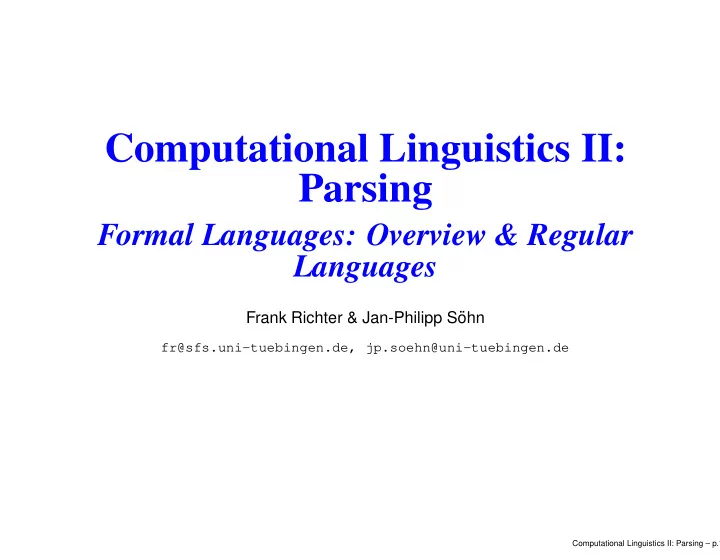

Computational Linguistics II: Parsing Formal Languages: Overview & Regular Languages Frank Richter & Jan-Philipp S¨ ohn fr@sfs.uni-tuebingen.de, jp.soehn@uni-tuebingen.de Computational Linguistics II: Parsing – p.1
Origins of Formal Language Theory Biology (neuron nets) Electrical Engineering (switching circuits, hardware design) Mathematics (foundations of logic) Linguistics (grammars for natural languages) Computational Linguistics II: Parsing – p.2
The Big Picture hierarchy grammar machine other type 3 reg. grammar DFA reg. expressions det. cf. LR(k) grammar DPDA type 2 CFG PDA type 1 CSG LBA type 0 unrestricted Turing grammar machine Computational Linguistics II: Parsing – p.3
The Big Picture hierarchy grammar machine other type 3 reg. grammar DFA reg. expressions det. cf. LR(k) grammar DPDA type 2 CFG PDA type 1 CSG LBA type 0 unrestricted Turing grammar machine DFA: Deterministic finite state automaton (D)PDA: (Deterministic) Pushdown automaton CFG: Context-free grammar CSG: Context-sensitive grammar LBA: Linear bounded automaton Computational Linguistics II: Parsing – p.3
Form of Grammars of Type 0–3 For i ∈ { 0 , 1 , 2 , 3 } , a grammar � N, T, P, S � of Type i , with N the set of non-terminal symbols, T the set of terminal symbols ( N and T disjoint, Σ = N ∪ T ), P the set of productions, and S the start symbol ( S ∈ N ), obeys the following restrictions: T3: Every production in P is of the form A → aB or A → ǫ , with B, A ∈ N , a ∈ T . T2: Every production in P is of the form A → x , with A ∈ N and x ∈ Σ ∗ . T1: Every production in P is of the form x 1 Ax 2 → x 1 yx 2 , with x 1 , x 2 ∈ Σ ∗ , y ∈ Σ + , A ∈ N and the possible exception of C → ǫ in case C does not occur on the righthand side of a rule in P . T0: No restrictions. Computational Linguistics II: Parsing – p.4
Deterministic Finite-State Automata Definition 1 (DFA) A deterministic FSA (DFA) is a quintuple (Σ , Q, i, F, δ ) where Σ is a finite set called the alphabet , Q is a finite set of states , i ∈ Q is the initial state , F ⊆ Q the set of final states , and δ is the transition function from Q × Σ to Q . Computational Linguistics II: Parsing – p.5
Transition Closure Definition 2 For each DFA (Σ , Q, i, F, δ ) , for each q ∈ Q , for each a ∈ Σ , for each x ∈ Σ ∗ , ˆ δ ( q, ǫ ) = q , and δ ( q, ax ) = ˆ ˆ δ ( δ ( q, a ) , x ) Computational Linguistics II: Parsing – p.6
Acceptance Definition 3 (Acceptance) Given a DFA M = (Σ , Q, i, F, δ ) , the language L ( M ) accepted by M is L ( M ) = { x ∈ Σ ∗ | ˆ δ ( i, x ) ∈ F } . Computational Linguistics II: Parsing – p.7
Recommend
More recommend